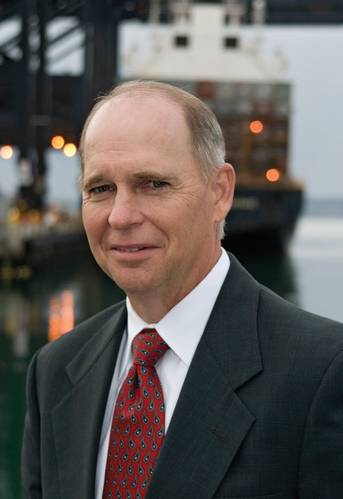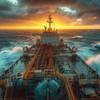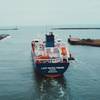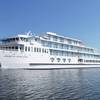Insights: Kurt J. Nagle, President and Chief Executive Officer Association of Port Authorities
Kurt Nagle needs no introduction to MarineNews readers. With more than 30 years of experience in seaports and international trade, he has since 1995 served as President and Chief Executive Officer for the American Association of Port Authorities (AAPA). Mr. Nagle began working at AAPA, the alliance of the leading public port authorities throughout the Western Hemisphere, in 1985. And, although some may associate him more with ‘bluewater’ issues, Nagle also knows that the health of all U.S. ports – including our inland waterways and tributaries – is also integral to the survival of America’s gateway, deepwater ports. This month, he weighs in and brings our entire intermodal equation into focus.
With regard to short-sea shipping, are bigger ports mostly focused on the Panama Canal expansion or are they thinking niche port deliveries from deep draft hubs, as well?
Ports are primarily focused on ensuring that facilities and connecting infrastructure is able to efficiently competitively handle the increasing trade volumes in the coming years. Several ports have benefitted from initial development of short-sea shipping networks, while many others are engaged in the effort to expand short-sea shipping as a viable alternative to moving goods via truck and rail along some of the busiest freight corridors. Short-sea shipping is one of a number of ways ports are working to become more competitive. While the Panama Canal expansion is a major and highly visible project, Panama itself is undertaking the expansion to maintain its competitiveness due to the global trade growth, increasing vessel sizes in the world fleet, dynamic trading patterns and other factors. Other countries are doing the same, and it’s critical for the United States to improve its transportation infrastructure, particularly in and around its seaports on all our coasts and the Great Lakes, to maintain and enhance U.S. international competitiveness. The canal expansion is but one of many factors driving infrastructure improvement projects. There are many other factors, including a growing population, increased demand for goods, new trade agreements, global competition and dynamic trade lanes. It’s critical that investments in transportation infrastructure be made today to ensure that we can support the movement of overseas and domestic cargo now and into the future. In the U.S., ports are responsible for developing facilities to handle more than 99% of this nation’s overseas cargo by volume. Ports and their private-sector partners are doing their part, investing more than $46 billion over the next five years in infrastructure, technology, terminal access and personnel improvements that will ensure America’s ports are able to accommodate the huge influx of trade.
What is the current situation with inland ports’ infrastructure needs and are they similar with the coastal ports’ needs?
The answer to this question can be found in the American Society of Civil Engineers’ 2013 infrastructure Report Card, which gave the inland waterways’ infrastructure a D-minus grade, while giving the coastal ports’ infrastructure grade a C. The key difference in these two grades was in the scope of research. The inland waterways’ infrastructure grade pertains chiefly to the poor state of the waterways, and locks and dams on those waterways, but not the infrastructure within the ports along those waterways. The grade given the coastal ports pertains to both the infrastructure within port authority boundaries and jurisdictions, and the land- and water-side connecting infrastructure that is outside the boundaries and jurisdictions of the ports. Because America’s deep-draft ports and their private-sector partners are making significant investments into their facilities, the infrastructure within port authorities is actually quite good, likely in the B range or better if that portion were being graded separately from the connecting infrastructure. The overall grade for the connecting infrastructure with deep-draft ports, however, would likely be in the D range if graded separately, similar to the grade given the inland waterways’ infrastructure. Averaging the likely B grade for port facility infrastructure with the D grade for connecting infrastructure, the result is a C.
Your constituent ports depend on you to do your job in Washington but they also compete amongst themselves. How do you set your agenda?
AAPA has member ports throughout the Western Hemisphere, not just the U.S. For our U.S. member deep-draft ports (which we call our “Corporate” members), the association provides representation and advocacy support in Washington, D.C., on a wide range of issues. The issues in which AAPA is active are determined by our U.S. Legislative Policy Council. There are many legislative and regulatory issues of common concern for U.S. ports, such as federal funding for port security grants and the Diesel Emission Reduction Act grants, the budget for the U.S. Army Corps of Engineers, and the need to address freight mobility in transportation reauthorization legislation.
With regard to dredging, are we getting done what we need nationwide at this time?
The short answer is no; our nation’s navigation channels are not ever being adequately maintained, much less improved where necessary. However, as the 2013 Water Resources Development Act (WRDA) legislation advances in Congress, we are seeing signs that our elected leaders are paying more attention to the needs of U.S. ports. Even so, much more support and recognition is needed, as was evident earlier this year with ports receiving a C grade for infrastructure by the American Society of Civil Engineering. Each of the 50 states relies on an average of 15 different seaports to handle their imports and exports, which means that the nation needs a diverse range of deep-draft seaports on each of the three coasts and the Great Lakes. It’s not necessary for some seaports to dredge beyond their current authorized depths because they tend to specialize in cargoes that arrive on smaller ships that don’t need channels as deep as 50 feet. The busiest 59 U.S. seaports are dredged to their authorized and necessary channel depths only about 35% of the time, and far fewer channels are dredged to their authorized widths, which is necessary both for safe and efficient bi-directional navigation, and because ships are being built wider as well as deeper. In addition, while the U.S. Army Corps of Engineers is currently deepening a few federal navigation channels and has additional studies underway, it’s vital that we have a timely process to identify and conduct needed improvements throughout the port system.
How much additional government funding is needed for the nation’s river and harbor dredging projects?
If Congress appropriated all the annual Harbor Maintenance Tax (HMT) revenues collected each year, the nation’s coastal ports and harbors could be fully maintained to their constructed depths and widths. The HMT generated $1.6 billion in revenues in fiscal 2012. The President’s fiscal 2014 budget requests $890M of HMT eligible work. The maintenance backlog would be accomplished over an estimated 5-7 years with full annual appropriation of the HMT.
Is there a national shortage of dredging equipment?
The U.S. Army Corps of Engineers successfully managed a dredging program twice the current annual program in the 2009-2010 timeframe when it simultaneously executed its annual program, executed post-hurricane supplemental appropriations and received ARRA funding. The Corps has two hopper dredges in a Ready Reserve status to be activated in the event no awardable bids are received from private industry. The dredging industry has several new dredges recently completed or under construction that will increase dredging capability.
Are you happy with what USACE is accomplishing at present? Could they do more?
AAPA considers the USACE a partner. To that end, AAPA and the Corps are working together on a Quality Partnership Initiative that addresses current industry issues and needs, and collaborates to enhance the Corps’ project study/delivery and communication processes, as well as changes to authorities and laws that would better facilitate the development and maintenance of the Corps’ coastal navigation projects. To see a copy of our 2012 Quality Partnership Initiative Report, click: http://aapa.files.cms-plus.com/Final%20QPI%20Report%2011_2012.pdf
The Number One issue facing your constituents – is it the same for smaller, more brown water-oriented ports as it is for the larger, so-called blue water gateways?
I think the Number One issue facing many U.S. ports, both shallow and deep draft, is the generally poor condition of the connecting transportation infrastructure in the water and on the land side of their facilities. For shallow draft ports, infrastructure investments need to be made in navigation dredging, repair and maintenance of locks and dams, and enhancements to the landside approaches to the inland ports. Except for lock and dam improvements—which aren’t associated with deep-draft ports—the concerns are similar for many deep-draft ports. The transportation connections to and from these port facilities – which are outside the jurisdiction and responsibility of the ports – are typically their biggest issues, since deep-draft ports and their private-sector partners have been making large investments in modernizing the infrastructure within their facility borders. Connecting infrastructure capital investments that are needed include: maintaining and deepening the deep-draft navigable waterways; reducing surface transportation congestion and grade conflicts on the roads and railways; and investing federal, state and local government resources into adding capacity to these connections to address not only today’s challenges, but those facing us in the years to come as population numbers and cargo demands grow.
The Water Resources Development Act is finally moving through Congress. What is AAPA’s take on the bill?
AAPA believes that WRDA should address three key areas that would result in real benefits for the nation. First is bill language that would ensure the federal Harbor Maintenance Tax (HMT) revenues are fully utilized each year. Second is to make the U.S. Army Corps of Engineers’ study and construction processes more efficient for future channel modernization projects. Third is to get channel modernization projects authorized and constructed to maintain America’s competitive advantage in transportation cost savings that results in domestic job creation and national economic vitality. More than $1.6 billion in HMT revenue was collected in fiscal year 2012 while the estimated surplus at the end of that year (Sept. 30, 2012) was more than $7 billion. By the end of this fiscal year (Sept. 30, 2013), it’s estimated the surplus in the Harbor Maintenance Trust Fund will be about $8 billion. The low appropriations have resulted in growing surpluses and an under-maintained system in which channels are not being maintained to their constructed depths and widths, despite adequate taxes being collected. Eight of the top 10 U.S. ports presently have depth or width restrictions resulting in safety risks of groundings and cargo spills and economic risks of light-loading ships which increase transportation costs, impacting the competitiveness of U.S. exports in the global marketplace and the cost of imported goods to U.S. consumers and manufacturers.
Passed by an 83-14 vote in the Senate on May 15, AAPA has been actively preparing for the next WRDA bill to address the investment and process changes needed to keep U.S. maritime infrastructure world class. To that end, AAPA has developed six guiding principles for WRDA legislation. They are:
Principle 1 – Fully utilize all HMT revenues in the year they were collected.
Principle 2 – Use HMT revenues first for funding the historical intended purposes, ensuring: 1) all federal navigation channels are brought up to and maintained at their constructed depths and widths; 2) needs are met for disposal of maintenance dredged material and construction and maintenance of confined disposal facilities; 3) jetties and breakwaters are properly maintained, and 4) related studies and surveys are funded.
Principle 3 – Provide more equity for HMT donors.
Principle 4 – Don’t allow U.S. tax policy to disadvantage U.S. ports and maritime cargo.
Principle 5 – Adopt a process to efficiently study and construct deep-draft U.S. navigation projects.
Principle 6 – Ensure the cost-share formula for maintenance and deepening is reflective of the current cargo fleet.
(As published in the June 2013 edition of Marine News - www.marinelink.com)
















